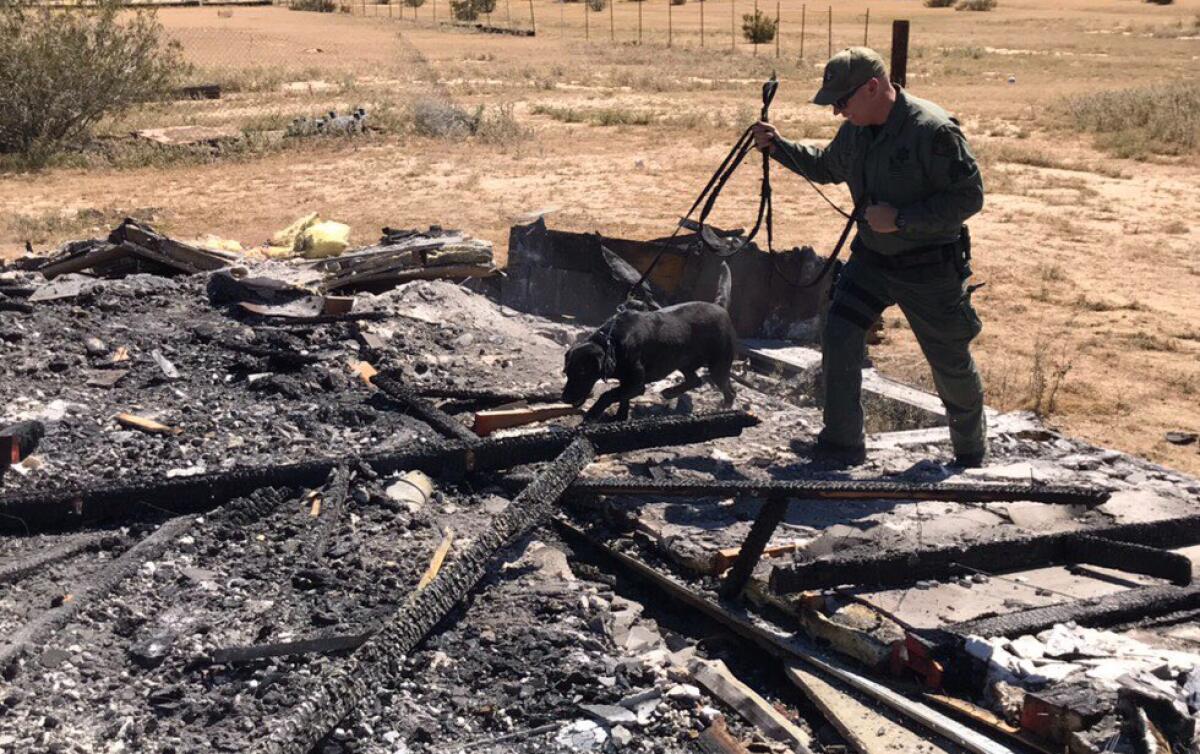Veterinarian contradicts Sheriff’s Department account of K-9 death

After a lawsuit was filed last week alleging that the death of a Los Angeles County Sheriff’s dog had been covered up, sheriff’s officials fired back, saying it was a bogus claim.
The department made public a memo detailing the findings of an internal inquiry into the 2020 incident. The memo, sheriff’s officials said, showed that the department had looked into what had happened and cleared the dog’s handler of negligence.
The memo cited a veterinarian, Yolanda Cassidy, who worked at the animal hospital where Spike, a black Labrador trained to detect accelerants used by arsonists to start fires, was brought for treatment after being left in a car for several hours. Cassidy, the report said, told a sheriff’s investigator the K-9 could have died from a number of things, including “heat, aspiration, and underlying medical conditions.”
But Cassidy now says the memo was “fabricated.”
In an interview with The Times, Cassidy said another veterinarian had tried to save Spike and that she was not even at the East Los Angeles Dog and Cat Hospital when the dog was rushed in. And though she was present a few days later when a sheriff’s lieutenant interviewed the vet who did treat Spike, she said she did not offer any opinion on what could have caused the dog’s death.
“I couldn’t say that, because I wasn’t there,” Cassidy said. She added later: “Maybe they expected me to cover them,” referring to the Sheriff’s Department.
The vet who Cassidy said did treat Spike could not be reached for comment Friday.
The Times reviewed a copy of part of a veterinary report from the East L.A. Dog and Cat Hospital about Spike’s death. It included a handwritten note that Spike “most likely passed of heat stroke that caused severe elevation of temperature.” It said he was unconscious and already dead when he arrived at the animal hospital on Sept. 29, 2020. The page of the report reviewed by The Times did not include the full name of the vet who tended to Spike.
The report is at odds with the Sheriff’s Department memo, which was dated Oct. 6 of that year. Former Lt. Sue Burakowski, who has since retired, told The Times on Friday that she wrote the memo.
Burakowski’s memo said the dog’s handler, Sgt. Dan Tobin, reported to work with Spike at 7 a.m. on the day the dog died. When he arrived, Tobin gave Spike some water and then put him back inside his county-issued Chevy Tahoe, the memo said.
Tobin left the engine on “secure idle” with the air conditioner running and a heat alarm activated, the memo said. Tobin checked on Spike at 9:30 a.m. and he was fine, according to the memo.
Tobin returned to his car at 12:45 p.m. to take Spike out of the car and noticed it was warm inside. He found Spike was unconscious and had vomited, the memo said. Tobin tried to wake Spike by spraying him with water from a garden hose, but it had no effect, Burakowski wrote in her memo. Tobin rushed him to the East L.A. Dog and Cat Hospital, where staff tried to revive him for 15 minutes, the memo said.
Tobin reported to Burakowski that his air conditioner was blowing warm air and that his heat alarm did go off, but not until he was driving to the veterinary clinic. The temperature outside that day was in the mid-90s, the memo said.
The next day, Tobin took his car to a mechanic who determined the air conditioner was low on freon, Burakowski wrote. Once the problem was addressed, the memo said, the cooling system began working again.
Despite the problems with the vehicle’s air conditioning and the fact that Spike died after being left inside the vehicle for several hours, the memo relied on expert insights Cassidy allegedly offered to leave open the question of how the dog died and to clear Tobin of wrongdoing.
Burakowski wrote that Cassidy told her the dog could have had an underlying medical condition, potentially from being exposed to chemicals and accelerants. The memo said Cassidy said heat may have exacerbated the condition.
Tobin “had no indication that his vehicle was not working properly, nor that his canine was not in good health,” the memo said. “A factor in the death of the canine is the county vehicle and its ability to function properly after seven years of service and 142,000 miles as a canine vehicle using the current protocol.”
Cassidy told The Times she didn’t say anything to Burakowski.
“She did not talk to me,” Cassidy said of Burakowski.
Burakowski told The Times she did speak with Cassidy.
When asked about the fact that the vet report did not raise the possibility that Spike was ill from chemicals or accelerants, Burakowski said she doesn’t know what level of detail vets are obligated to include in their reports.
“That’s why I did a follow-up with Yolanda, who I knew, who was familiar with our dogs,” Burakowski said. “That’s why I went back and talked to her and said, ‘Hey, here’s how he was presenting what’re your thoughts on this?’ We discussed a myriad of things.”
She said based on her findings, the incident did not warrant a full investigation by the department.
“There were just a series of unfortunate things that happened that day and prior to that day that caused the death of Spike. We don’t know exactly what caused his death,” she said.
Cassidy also said that a few months ago, Chief Joe Williams, who at the time of Spike’s death was a captain overseeing the arson unit, called her complaining that Lt. Joseph Garrido — who filed the lawsuit last week — was speaking out about Spike. She said that when she told Williams she had not treated the dog, he had sounded surprised.
Garrido alleged in his lawsuit that the dog’s death was not investigated.
Williams did not return a call requesting comment. Tobin declined to comment, referring questions to the Sheriff’s Information Bureau.
More to Read
Sign up for Essential California
The most important California stories and recommendations in your inbox every morning.
You may occasionally receive promotional content from the Los Angeles Times.










